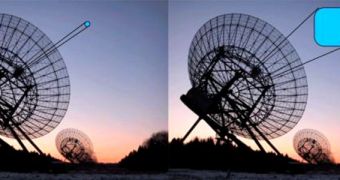Researchers operating the Westerbork Synthesis Radio Telescope (WSRT) in the Netherlands are pioneering a new approach to conducting space observations in radio wavelengths. They are outfitting some of their antenna dishes with detector plates that boost the observatory's field of view.
The WSRT contains a total of 14 radio antennas, and only one of them got the new plate of detectors. The device was mounted on the focal plane of the instrument. The work was coordinated by astronomers at the Netherlands Institute for Radio Astronomy (ASTRON).
Such innovations,if widely-adopted, could usher in a new era of radio space exploration. Their main benefit is that they increase the swath of night sky that a single antenna can cover at any given time.
Utilizing the sensor plates on just one antenna gave the WSRT team the ability to image two pulsars (a special type of neutron stars) at the same time, even if the bodies were separated by 3.5 arc-degrees.
This are occupies a region of space as large as 7 times the size of the full Moon as seen from our planet. Experts estimate that adding the sensors can boost fields of view by more than 30 times over.
ASTRON experts dubbed the new project Apertif. The plate installed on the WSRT antenna works under a principle known as phased array feed (PAF), and features no less than 121 individual detectors.
The arrays do not boost the efficiency of the antenna directly, in the sense that it does not become more sensitive. Rather, it makes it more responsive to analyzing larger swaths of sky at the same time.
Apertif project principal investigator, Dr. Tom Oosterloo, explains that “the phased array feed consists of 121 small antennas, closely packed together. This matrix covers about 1 square meter.”
“Each WSRT will have such a antenna matrix in its focus. This matrix fully samples the radiation field in the focal plane,” he goes on to say, quoted by Universe Today.
“By combining the signals of all 121 elements, a ‘compound beams’[sic] can be formed which can be steered to be pointing at any location inside a region of 3×3 degrees on the sky,” the expert reveals.
The overall response of the telescope is then optimized by combining the signals coming from all 121 elements on each sensor plate.
“This process is done in parallel 37 times, i.e. 37 compound beams are formed. Each compound beam basically functions as a separate telescope. If we do this in all WSRT dishes, we have 37 WSRTs in parallel,” Oosterloo reveals.
“By steering all the beams to different locations within the 3×3 degree region, we can observe this region entirely,” he concludes.

 14 DAY TRIAL //
14 DAY TRIAL //